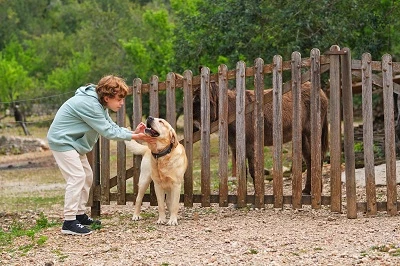As the demand for eco-friendly businesses continues to rise, incorporating sustainable practices into a farm-style dog boarding facility can not only reduce environmental impact but also attract a growing market of environmentally conscious pet owners. Here’s how to integrate sustainability into your farm-style dog boarding business.
1. Eco-Friendly Facility Design
Use Sustainable Building Materials
When constructing or renovating your boarding facility, opt for sustainable building materials. Use reclaimed wood, recycled steel, and eco-friendly insulation. These materials reduce your carbon footprint and often provide unique, rustic aesthetics that enhance the farm atmosphere.
Energy-Efficient Systems
Install energy-efficient lighting, heating, and cooling systems. LED lights, solar panels, and energy-efficient HVAC systems can significantly reduce energy consumption. Implementing motion sensors for lights in less frequently used areas can also save energy.
Water Conservation
Implement water-saving fixtures such as low-flow faucets and toilets. Consider rainwater harvesting systems to collect and store rainwater for cleaning, watering gardens, and other non-potable uses. Installing a greywater recycling system can further reduce water waste.
2. Sustainable Operations
Organic and Locally Sourced Food
Provide organic and locally sourced food for the dogs in your care. This supports local farmers and reduces the carbon footprint associated with transporting food. Organic options also ensure that dogs receive high-quality, chemical-free nutrition.
Eco-Friendly Cleaning Products
Use biodegradable, non-toxic cleaning products to maintain hygiene without harming the environment. These products are safer for the dogs and staff and prevent harmful chemicals from contaminating local water sources.
Waste Management
Implement a comprehensive waste management plan. Use compostable bags for pet waste and establish a composting system for organic waste. Partner with a local waste management company that specializes in recycling and composting to ensure proper disposal.
3. Green Outdoor Spaces
Native Landscaping
Plant native trees, shrubs, and grasses to create a sustainable landscape that supports local wildlife and reduces water usage. Native plants require less maintenance and are more resistant to local pests and diseases.
Organic Gardening
If your facility includes gardens or green spaces, practice organic gardening. Avoid chemical pesticides and fertilizers, opting instead for natural alternatives like compost and organic mulch. This creates a safer environment for the dogs and enhances biodiversity.
Sustainable Dog Play Areas
Design play areas with sustainability in mind. Use natural materials like wood and stone for structures and avoid artificial turf, which can be harmful to the environment. Ensure play areas are shaded to reduce heat stress on dogs during hot weather.
4. Community Engagement and Education
Educate Staff and Clients
Educate your staff and clients about the importance of sustainability and how they can contribute. Provide training on eco-friendly practices and offer resources for clients to implement sustainable practices at home.
Community Involvement
Engage with the local community by hosting educational workshops on sustainability and pet care. Partner with local environmental organizations to promote green initiatives and participate in community clean-up events.
Support Local Economy
Source supplies and services from local businesses whenever possible. This not only supports the local economy but also reduces the carbon footprint associated with transportation.
5. Continuous Improvement
Monitor and Evaluate
Regularly monitor your facility’s environmental impact and evaluate the effectiveness of your sustainability initiatives. Use metrics such as energy and water consumption, waste generation, and sourcing practices to measure progress.
Seek Certifications
Consider obtaining certifications such as LEED (Leadership in Energy and Environmental Design) or Green Globe. These certifications can validate your efforts and enhance your facility’s reputation as an eco-friendly business.
Innovate and Adapt
Stay informed about new sustainable practices and technologies. Continuously seek ways to innovate and improve your sustainability efforts. Engaging with industry associations and attending sustainability conferences can provide valuable insights and inspiration.
Conclusion
Incorporating sustainable practices into a farm-style dog boarding facility not only benefits the environment but also appeals to a growing market of eco-conscious pet owners. By adopting eco-friendly building materials, energy-efficient systems, sustainable operations, and community engagement, you can create a business that is both profitable and environmentally responsible. Embracing sustainability in every aspect of your operations ensures that your facility provides a healthy, safe, and enjoyable environment for the dogs in your care and contributes positively to the


